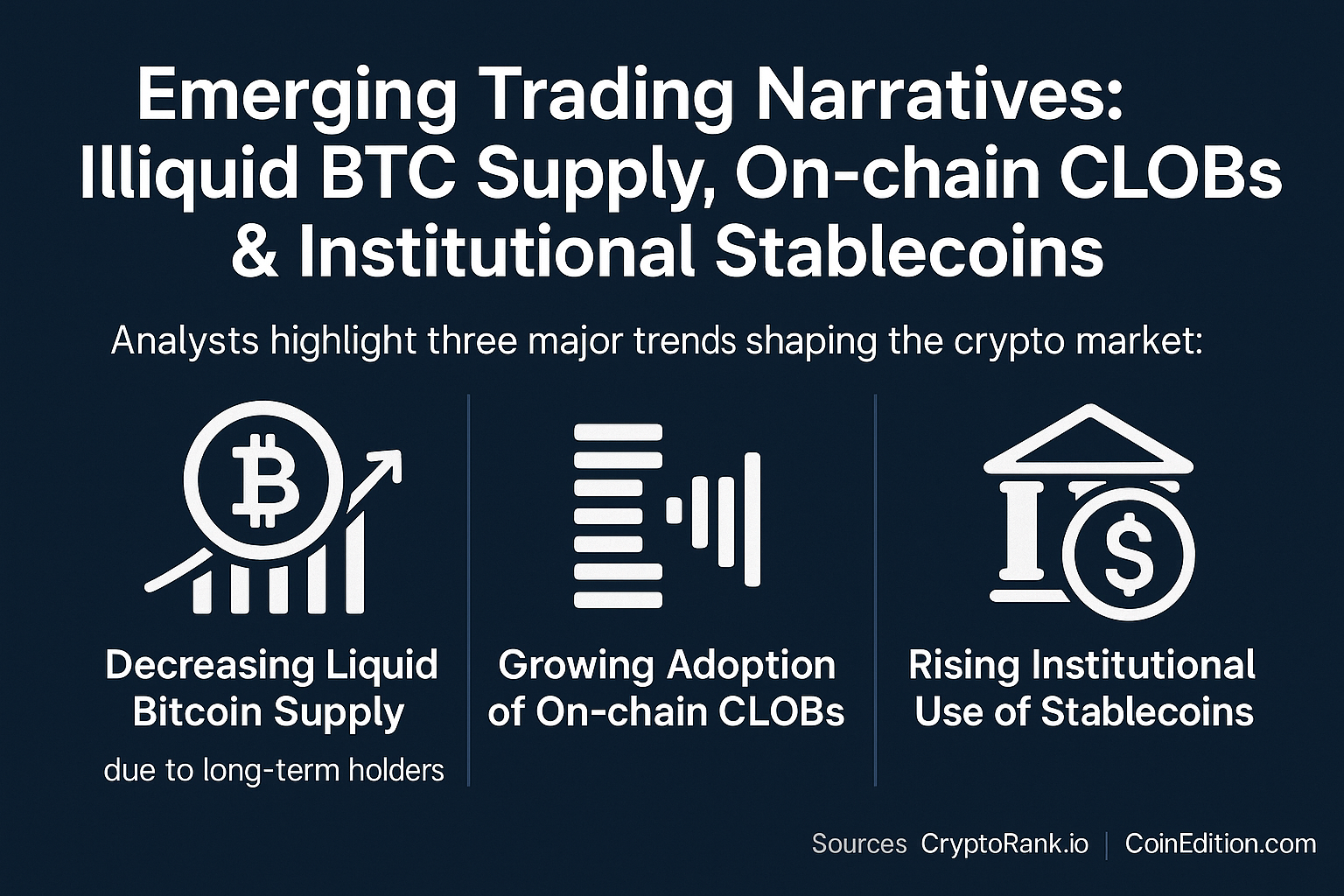As the digital asset market matures, analysts are witnessing a distinct evolution in the narratives driving market behavior and infrastructure development. While price action often dominates headlines, the foundations of crypto market structure are shifting in meaningful ways. Three emerging trends—dwindling liquid Bitcoin supply, adoption of on‑chain central limit order books (CLOBs), and rising institutional use of stablecoins—are coming into sharper focus and may define the next phase of crypto’s evolution.
1. Decreasing Liquid Bitcoin Supply: Long-Term Holders Dictate Market Dynamics
One of the clearest signals of a changing market is the decreasing availability of Bitcoin in liquid circulation. On-chain analytics reveal that a growing proportion of BTC is being held in long-term wallets—those with no movement over 155 days or more—reaching all-time highs.
This signals increasing conviction among investors and reinforces Bitcoin’s emerging role as a digital store of value. With fewer coins available on exchanges and lower active supply, price volatility could be amplified in both directions. Moreover, this scarcity is not driven by protocol mechanics alone but by human behavior: the belief in Bitcoin’s long-term potential is literally locking coins out of reach.
In the short term, this could constrain trading activity and raise slippage risks for large buys. In the long term, it strengthens Bitcoin’s narrative as a scarce digital asset with robust holding patterns—a trend that historically precedes bullish market cycles.
2. On-Chain CLOBs Gain Ground: A New Era for Decentralized Market Infrastructure
Central limit order books—traditionally a hallmark of centralized exchanges—are now increasingly being implemented on-chain. This is not just a technological feat, but a conceptual leap in how markets can operate without intermediaries.
Platforms like dYdX v4, Sei, and Vertex Protocol are leading the charge, offering high-speed, on-chain order matching with near parity to the performance of traditional platforms. This represents a notable evolution beyond automated market makers (AMMs), which have so far dominated decentralized finance (DeFi).
CLOBs allow for greater control over order execution, tighter spreads, and more efficient price discovery. Their rise reflects growing demand from sophisticated traders and institutions looking for DeFi-native solutions with professional-grade tooling. As these systems mature, they may become the backbone for decentralized exchanges (DEXs) that rival their centralized counterparts in speed and reliability.
3. Institutional Stablecoin Usage Accelerates: From Trading Tool to Settlement Rail
Stablecoins are no longer just a tool for crypto-native traders. Increasingly, they are becoming vital infrastructure for institutions. Reports show a sharp uptick in stablecoin usage across centralized exchanges, custody solutions, and private settlement layers used by financial entities.
USDC, USDT, and newer entrants like PYUSD are finding applications beyond speculative trading. From cross-border remittances and yield-bearing DeFi integrations to instant on-chain settlements for traditional finance (TradFi) institutions, stablecoins are rapidly embedding themselves into the global financial system.
Recent partnerships between blockchain networks and traditional banks—as well as regulatory clarity in jurisdictions like Singapore and the EU—have only accelerated this trend. In effect, stablecoins are serving as a digital bridge between fiat and crypto economies, facilitating capital flows with unprecedented efficiency and transparency.
Why These Narratives Matter
The convergence of these three trends is not coincidental. They represent an ecosystem transitioning from speculation to structure, from retail-driven exuberance to institutional-grade infrastructure. Long-term Bitcoin holding strengthens the asset’s legitimacy. On-chain CLOBs improve market efficiency and democratize access to order book trading. Institutional stablecoin usage embeds crypto into global finance workflows.
As we move deeper into the 2020s, these narratives may not only influence price but reshape how markets function entirely. Whether you’re a retail investor, a developer, or a hedge fund manager, understanding these shifts is crucial to navigating the next era of crypto.




